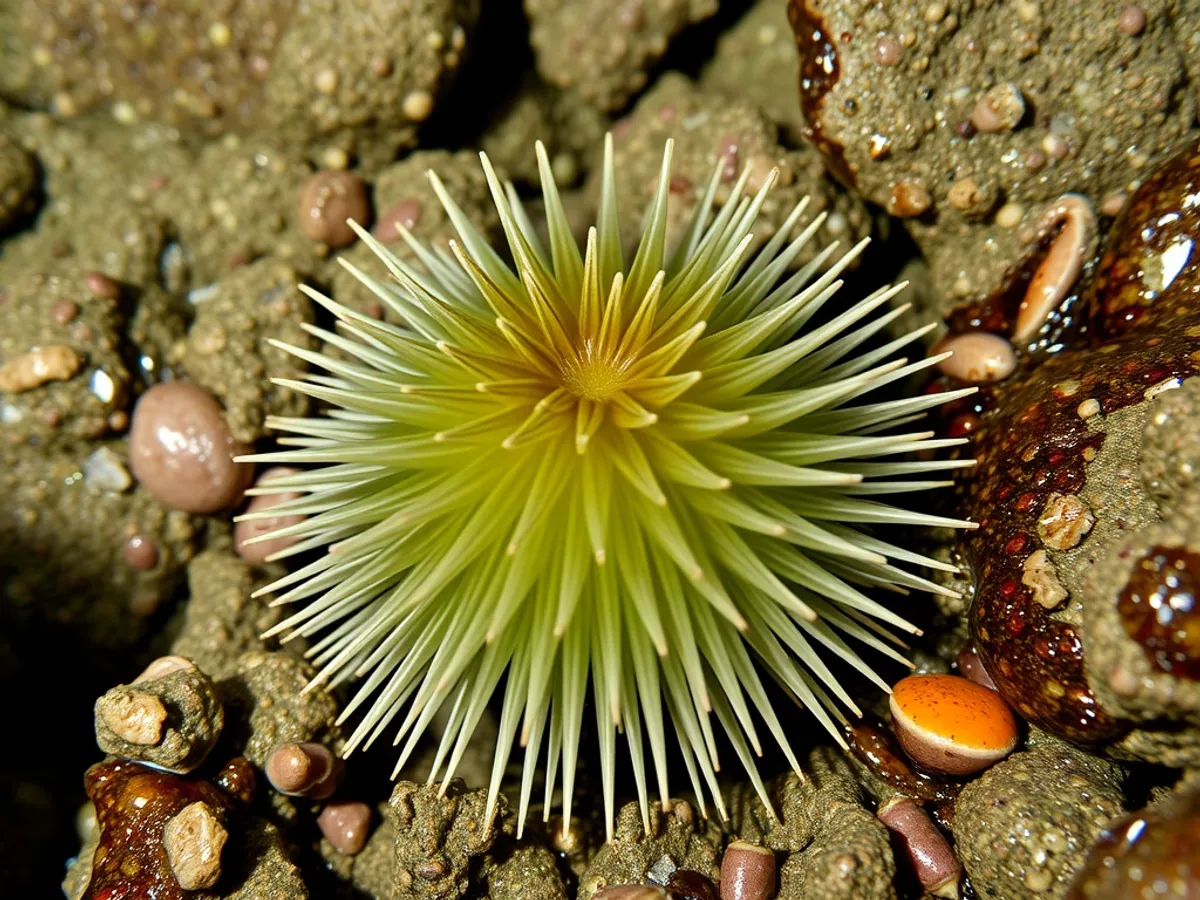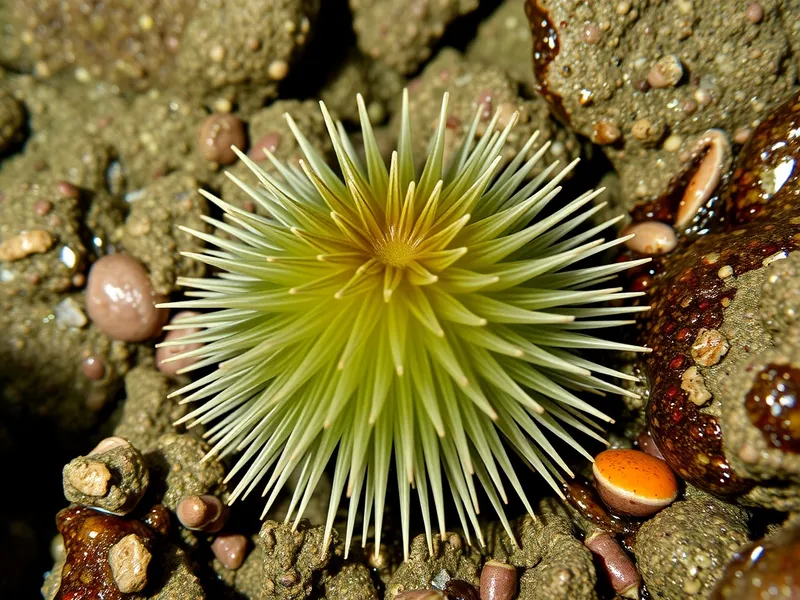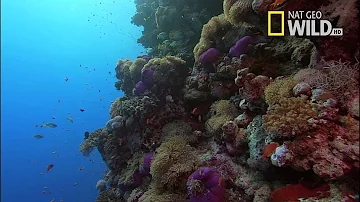
Green sea urchin
Strongylocentrotus droebachiensis

Meet the Green sea urchin
The green sea urchin is a small, spiny invertebrate found in cold, shallow waters of the North Atlantic and Arctic Oceans. Its spherical body is covered with short, greenish spines that provide protection from predators and aid in locomotion. Green sea urchins play a crucial role in their ecosystem by grazing on algae, helping to maintain the balance of marine habitats. They are also harvested in some regions for their roe, which is considered a delicacy. Despite their slow movement, green sea urchins are remarkable survivors, adapting to a variety of harsh marine environments.
Classification
Invertebrate
Habitat
Rocky ocean bottoms and kelp forests in cold, shallow coastal waters
Diet
Herbivore
Lifespan
6-30 years
Conservation
Least Concern
Weight
30-50 grams
📖Fascinating Facts
Spiny Armor
The green sea urchin's short, densely packed spines help deter predators and are also used for movement along the ocean floor.
Vital Ecosystem Role
By grazing on kelp and algae, green sea urchins help prevent overgrowth and support healthy marine ecosystems.
Culinary Delicacy
The roe of green sea urchins, known as uni, is considered a delicacy in many cuisines, especially in Japan.
📋Detailed Description
Strongylocentrotus droebachiensis, commonly known as the green sea urchin, is a globular echinoderm typically measuring 3–8 cm in diameter, though individuals can reach up to 9 cm. Its test (external skeleton) is covered with short, dense spines that range in color from olive green to yellowish, providing camouflage among seaweeds and rocky substrates. The spines are interspersed with tube feet, which are used for locomotion, respiration, and sensory perception. The mouth, located on the underside, contains a specialized feeding structure called Aristotle’s lantern, composed of five calcareous teeth for scraping algae and biofilm from rocks. Green sea urchins are primarily nocturnal, often hiding in crevices during the day and emerging at night to graze. They are generally solitary but can aggregate in high densities, especially in areas with abundant food. Reproduction is external, with both sexes releasing gametes into the water column during synchronized spawning events, often triggered by temperature changes in late winter to early spring. Larvae are planktonic and undergo several developmental stages before settling to the benthos. Green sea urchins are highly adaptable, tolerating a wide range of salinities and temperatures, and are capable of regenerating lost spines and tube feet. Their ecological role as grazers is vital in controlling algal growth and maintaining the health of kelp forest ecosystems.
💡 Did you know?
Some green sea urchins can live up to 100 years in the wild under optimal conditions.
🔬Research & Sources
Wikipedia Summary
Several species of sea urchin share the name green sea urchin:Lytechinus variegatus, also known as the variegated sea urchin Psammechinus microtuberculatus, occurs in the Atlantic Ocean, Adriatic Sea, Aegean Sea and Mediterranean Psammechinus miliaris, also known as the shore sea urchin Strongylocentrotus droebachiensis, common in northern waters all around the world
Last Modified: 10/5/2022
🎭Behavior & Social Structure
Green sea urchins are primarily herbivorous, feeding on macroalgae such as kelp, as well as diatoms and detritus. They use their tube feet and spines to move slowly across the substrate, often traveling several meters per day in search of food. Feeding occurs mostly at night to avoid predation. When food is scarce, they may exhibit opportunistic omnivory, consuming sessile invertebrates or even conspecifics. Social interactions are limited, but high-density aggregations can form, sometimes leading to 'urchin barrens' where overgrazing eliminates kelp forests. They exhibit a strong escape response to predators such as sea otters, crabs, and certain fish, retracting spines and seeking shelter in crevices. Daily routines are influenced by tidal cycles and light availability, with increased activity during low light conditions.
👶Reproduction & Life Cycle
Strongylocentrotus droebachiensis is dioecious, with separate male and female individuals. Spawning typically occurs annually from late winter to early spring, though timing can vary with latitude and local conditions. Gametes are released synchronously into the water column, where external fertilization takes place. Fertilized eggs develop into planktonic echinopluteus larvae, which drift for 4–8 weeks before settling and metamorphosing into juvenile urchins. There is no parental care post-spawning. High fecundity is typical, with a single female capable of releasing several million eggs per spawning event. Recruitment success is highly variable and influenced by ocean currents, predation, and food availability.
🛡️Adaptations & Survival
Green sea urchins possess several adaptations for survival in cold, dynamic marine environments. Their spines and pedicellariae (tiny pincer-like structures) deter predators and prevent fouling by algae and parasites. Tube feet, equipped with suction discs, allow for strong adhesion to rocky substrates and facilitate movement and gas exchange. The Aristotle’s lantern enables efficient grazing on tough algal surfaces. Physiologically, they can tolerate low temperatures (as low as -1.8°C) and variable salinities, making them well-suited to Arctic and subarctic habitats. Their ability to regenerate lost spines and tube feet is crucial for recovery from predation or environmental damage. Behavioral plasticity, such as shifting diet and movement patterns, enhances their resilience to changing ecological conditions.
📚Research Sources
🎨Cultural Significance
Green sea urchins have significant economic and cultural importance in several regions. Their roe, known as 'uni,' is a prized delicacy in Japanese cuisine and is also consumed in Europe and North America. Traditional harvesting by Indigenous peoples in the North Atlantic has been documented, with urchins serving as a local food source. Symbolically, sea urchins are sometimes associated with resilience and adaptability in coastal folklore. In scientific research, they are model organisms for developmental biology due to their transparent embryos and well-characterized genetics.
🔬Recent Research & Discoveries
Recent studies have focused on the impacts of ocean acidification on green sea urchin calcification and larval development, revealing potential vulnerabilities to future climate scenarios. Genomic research has provided insights into their immune system and regenerative capabilities. Ecological studies have examined their role in kelp forest dynamics, particularly the feedback loops between urchin grazing, predator abundance, and habitat structure. Ongoing research is also investigating sustainable aquaculture practices to reduce pressure on wild populations and improve roe quality for commercial markets.
🎥Wildlife Videos

Our Planet | Coastal Seas | FULL EPISODE | Netflix
Experience our planet's natural beauty and examine how climate change impacts all living creatures in this ambitious ...
Netflix

Species Spotlight - Green sea urchin (Psammechinus miliaris)
Species spotlight - green sea urchin (psammechinus miliaris) The Green sea urchin (Psammechinus miliaris) is a small spiny ...
GHMarineBio

Army of Sea Urchins? | Planet Earth | BBC Earth
Sea urchins gather in large enough numbers to form an army. Subscribe: http://bit.ly/BBCEarthSub WATCH MORE: New on Earth: ...
BBC Earth

Desert Seas Narrated by David Attenborough | National Geographic Documentary
Along the east and west coasts of Saudi Arabia are two seas that contain a treasure of marine life that few knew existed -- and ...
J Roz

DEEP OCEAN: Life in the Cold Abyss | Secrets of the Seas Ep. 1 | Nature Animal Documentary
DEEP OCEAN: Life in the Cold Abyss | Secrets of the Seas Ep. 1 | Nature Animal Documentary More than eighty percent of the ...
Nature's Moments

Spiky sea urchins feed on kelp
Visit http://www.earth-touch.com for a closer look at the wonders of the natural world. A super klipfish disguises itself among the ...
Earth Touch
🌍Habitat Information
The Green sea urchin typically inhabits Rocky ocean bottoms and kelp forests in cold, shallow coastal waters environments. Green sea urchins have adapted to their environments with specialized features and behaviors.
Primary Habitat:
Rocky ocean bottoms and kelp forests in cold, shallow coastal waters
More detailed habitat information will be available soon.
🛡️Conservation Status
The Green sea urchin is currently classified as Least Concern. Conservation efforts are crucial for preserving this species for future generations.
Common Threats:
- 🏠Habitat loss and fragmentation
- 🌡️Climate change impacts
- 🎯Hunting and poaching
- 🏭Human-wildlife conflict
⚠️Threats & Conservation Challenges
While currently listed as Least Concern, green sea urchin populations face several threats. Overharvesting for their roe, particularly in North America and Europe, has led to localized declines. Climate change poses risks through ocean warming, acidification, and altered current patterns, which can affect larval survival and food availability. Disease outbreaks, such as those caused by pathogenic bacteria or parasites, have also been documented. In some regions, the removal of predators (e.g., sea otters) has led to population explosions and subsequent ecosystem imbalances, resulting in urchin barrens. Conversely, in areas with heavy fishing pressure, populations may be unable to recover quickly due to slow growth and variable recruitment.
🔬Scientific Classification
Scientific Name
Strongylocentrotus droebachiensis
Classification Hierarchy
🔍 About Taxonomic Classification
Taxonomic classification is a hierarchical system used by scientists to classify and organize living organisms based on shared characteristics and evolutionary relationships.
The system moves from broad categories (Kingdom) to increasingly specific ones, with each animal's scientific name typically consisting of its Genus and species.
📝Community Notes
Share your observations and insights about the Green sea urchin with our community of wildlife enthusiasts.
Join Our Community
Sign in to share your observations and connect with fellow wildlife enthusiasts.
Sign In to ContributeNo community notes yet
Be the first to share your observations about the Green sea urchin!
Explore Green sea urchin
Select a tab above to learn more about this amazing animal.
📸Photo Gallery
No photos available for this animal yet.
🌟Discover More Wildlife
Continue your journey of discovery with more fascinating animals from our database
